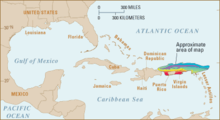Milwaukee Deep
Location of the Milwaukee Depression north of Puerto Rico |

The Milwaukee Depth is the deepest point in the Atlantic Ocean at around 8,400 m and is located on its western edge in the Puerto Rico Trench and within the Brownson Depression, which is unclearly delimited from it . It is 122.3 km north of Punto Palmas Altas the municipality Manati off the coast of Puerto Rico and was named after the US - cruiser USS Milwaukee named, discovered the depth on February 14 1939th
The first recorded information on the depth of the sea in this area (Brownson Deep / Puerto Rico Trench) comes from measurements taken by the brig USS Dolphin in 1852, after which it was given as 7000 m. It is recorded as dolphin depth in 1940 in the nomenclature report of the Society for Physical Oceanography, where the depth is given as 8525 m.
Information about its depth currently ranges from 8,380 m to 9,219 m, with the second value based solely on the computationally corrected echo sounder measurement of the USS Milwaukee. Measurements following the surveys of the Milwaukee always resulted in values of less than 9000 m. So found z. B. as early as 1942 by Svedrup et al. in one of the first overview books on oceanography the indication 8750 m. Another echo sounder measurement in 1954 showed a depth of only 8380 m.
Currently, a value around 8400 m can be considered likely, as it results from the information in the overview article by Stewart and Jamieson (8740, 8710 and 8526 m) from the year 2019 and in particular the result of Victor Vescovo's 2018 dives . The deep-sea submarine " Limiting Factor " reached the approximately flat deep- sea floor for the first time directly at 8376 m.
See also
Individual evidence
- ↑ a b Heather Ann Stewart, Alan J. Jamieson: The five deeps: The location and depth of the deepest place in each of the world's oceans . In: Earth Science Reviews . 197, July 9, 2019, p. 102896. doi : 10.1016 / j.earscirev.2019.102896 .
- ^ A b J. Lyman: The Deepest Sounding in the North Atlantic . In: Proceedings of the Royal Society of London. Series A, Mathematical and Physical Sciences . 222, No. 1150, March 18, 1954, pp. 334-336.
- ↑ T. Wayland Vaughan et al .: Report of the committee on the criteria and nomenclature of the major divisions of the ocean bottom . (pdf; 10.5MB) In: International Association for the Physical Sciences of the Oceans (IAPSO) Publications Scientifiques . 8, 1940.
- ↑ Harald Ulrik Svedrup, Martin Wiggo Johnson, Richard Howell Fleming: The Oceans: Their Physics, Chemistry, and General Biology . Prentice-Hall Inc., New York 1942, LCCN 43-051021 , OCLC 845586517 , p. 19.36 (English, 1087 pp., Cdlib.org [accessed February 28, 2020]).
- ^ David Strege: Explorer makes history by completing Five Deeps Expedition ( en ) USA Today. September 9, 2019. Accessed February 28, 2020.
Coordinates: 19 ° 35 ′ 0 ″ N , 66 ° 30 ′ 0 ″ W.

